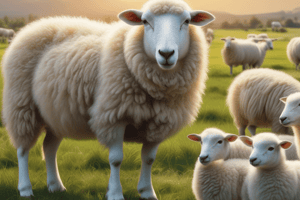Podcast
Questions and Answers
What does path analysis primarily study?
What does path analysis primarily study?
- The direct effects of causal variables only
- The interaction effects among multiple variables
- The direct and indirect effects of variables on response variables (correct)
- The overall correlation between variables
Which of the following assumptions about path analysis is NOT true?
Which of the following assumptions about path analysis is NOT true?
- Only one-way causation is accounted for
- There is a requirement for a linear relationship among variables
- The variables should be measured on an interval scale
- Interaction effects among variables are considered (correct)
In the context of path analysis, what is meant by 'residual or unmeasured parts'?
In the context of path analysis, what is meant by 'residual or unmeasured parts'?
- The parts that can be used as predictive indicators
- The parts that cause significant errors in the model
- The parts that are uncorrelated with any variables in the model (correct)
- The parts that are highly correlated with other variables
Why is adequate sample size important in path analysis?
Why is adequate sample size important in path analysis?
Which condition must be satisfied regarding multicollinearity in path analysis?
Which condition must be satisfied regarding multicollinearity in path analysis?
In path analysis, how is the direct effect of a causal variable quantified?
In path analysis, how is the direct effect of a causal variable quantified?
Which best describes the role of path coefficients in path analysis?
Which best describes the role of path coefficients in path analysis?
What happens when a significant causal variable is omitted from a path analysis model?
What happens when a significant causal variable is omitted from a path analysis model?
What does path coefficient analysis primarily help to separate in a breeding program?
What does path coefficient analysis primarily help to separate in a breeding program?
In path coefficient analysis, the variables that influence the response variable directly are referred to as what?
In path coefficient analysis, the variables that influence the response variable directly are referred to as what?
What does a path diagram represent in the context of path coefficient analysis?
What does a path diagram represent in the context of path coefficient analysis?
Which of the following statements is true regarding endogenous variables in a path analysis?
Which of the following statements is true regarding endogenous variables in a path analysis?
What does a one-way arrow in a path diagram indicate?
What does a one-way arrow in a path diagram indicate?
Which of the following represents an indirect effect in the context of yield components?
Which of the following represents an indirect effect in the context of yield components?
What represents the relationship among yield components in a breeding context?
What represents the relationship among yield components in a breeding context?
Which statement best describes the nature of multiple regression in path analysis?
Which statement best describes the nature of multiple regression in path analysis?
Study Notes
Conventional Breeding and Path Coefficient Analysis
- Selection in breeding programs focuses on characters that enhance response variables.
- Characters exhibit correlations with responses and with one another, complicating the analysis of their individual effects.
- Path Coefficient Analysis is utilized to isolate direct influences of specific variables on response variables while accounting for interrelationships among all variables.
Path Coefficient Analysis Overview
- Path analysis is a refined form of multiple regression analysis with two groups of variables:
- Exogenous (Independent): Variables that influence others.
- Endogenous (Dependent): Variables influenced by others.
- Path coefficients represent both direct and indirect influences of variables on dependent outcomes.
Path Diagram Components
- A path diagram visually represents causal relationships, indicating the direction of effects among variables.
- Independent variables (e.g., X1, X2, X3) lead to dependent variables (e.g., X4, X5).
- Both way arrows indicate interdependence among endogenous variables, whereas one-way arrows show unilateral causation from exogenous to endogenous variables.
Understanding Effects
- Effects of yield components involve both direct relationships (immediate impact) and indirect relationships via other variables.
- The overall effect between a component variable and the response variable is the sum of its direct and indirect effects.
- The formula for effect partitioning:
- ( ai + \sum_{i' \neq i}bi' = r_{xy} )
- where ( ai ) is the direct effect, and ( bi' ) represents indirect effects of other variables.
Purpose of Path Analysis
- Path analysis clarifies direct and indirect relationships, merging quantitative correlation data with qualitative causal insights.
- It is not aimed at identifying causal genesis but at interpreting the effect magnitude and direction.
Assumptions of Path Analysis
- Assumes linear relationships exist among all variables.
- All effects are considered additive, with no interactive effects.
- Follows a one-way causation framework (recursive model).
- Variables should be measured on an interval scale; categorical variables coded as dummy variables must form distinct blocks in the diagram.
- Residual or unmeasured components are uncorrelated with model variables.
- Requires low multicollinearity; high multicollinearity skews regression coefficient standard errors.
- The model must be correctly specified, avoiding omission of significant causal variables.
- Adequate sample sizes are essential; recommended practice suggests 10 cases for each parameter in the model to ensure significance testing robustness, while 5 or fewer cases are inadequate.
Studying That Suits You
Use AI to generate personalized quizzes and flashcards to suit your learning preferences.
Description
This quiz delves into the principles of conventional breeding programs, exploring how different characters are selected based on their effects on response variables. It addresses the complex relationships between characters and their direct influences, providing a comprehensive understanding of breeding techniques in agriculture.




